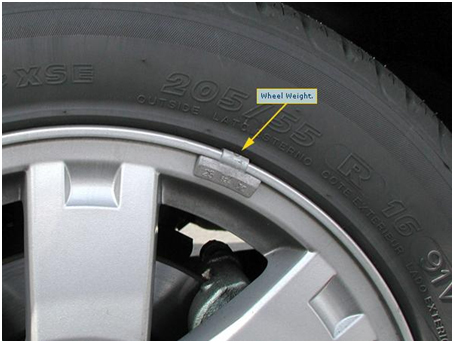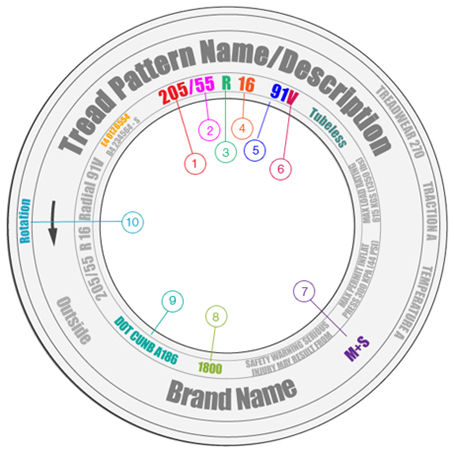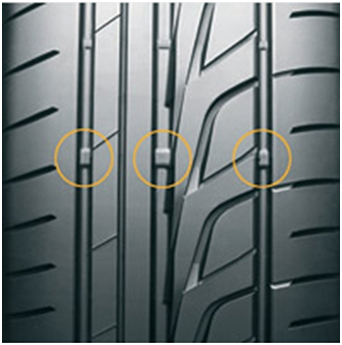Services Offered
Easy Tyre 123 Services
- Supply & fitment of new tyres
- Fitment of your own tyres
- Tyre fitment for both Cars & Vans (up to 3.5ton)
- Wheel balancing
- Valve fitment
- Puncture Repairs to national standard
- Front wheel alignment
- Battery Supply and Fitment
Looking after your tyres
We recommend you check your tyres at lease every 2 weeks.
Maintaining correct Tyre Pressure.
There are 3 main reasons why maintaining the right tyre pressure is important. The first is safety. Tyres that are under inflated can overheat, and over inflated can lead to poor vehicle handling on the road.
The second reason is economy. Over or under inflated tyres suffer more damage than those with the correct pressure and need to be replaced more regularly. Vehicles with under-inflated tyres have increased rolling resistance that requires more fuel to maintain the same speed.
The third reason for maintaining the correct tyre pressure is the environment. Correct tyre pressure helps to maintain fuel efficiency. This can equate to lower CO2 emissions coming from your vehicle.
The correct tyre pressure setting for your vehicle is in your vehicle Handbook and also displayed on the driver's side door sill.
Always check tyre pressure with a tyre pressure gauge when your tyres are cold.
Check for external damage.
Cuts, lumps and bumps are often caused by the impact between the tyre and the gutter, pothole or an object on the road. If your tyre has any of these symptoms then you must have the tyre checked by a specialist, as this sort of damage can lead to sudden tyre failure.
Wheel alignment is also an important step in maintaining and prolonging the life of your tyres. Kerbing or potholes affect your vehicles wheel alignment settings which can lead to rapid or uneven tyre wear. We recommend that the wheel alignment is checked every time new tyres are fitted.
Also, emergency braking can sometimes leave your tyres with a "flat spot". This can be another reason for premature tyre replacement. If you have any concern or are in any doubt over the state of your tyres please seek specialist advice.
It's a driver's responsibility
UK Law requires that your vehicle is fitted with the correct type and size of tyres for your vehicle type and for the purpose it is being used. This means fitting the right tyres and ensuring they are inflated to the recommended pressure.
Wheel Balancing
Wheels that are not balanced or are out of balance generally produce a vibration that is uncomfortable to drive on and results in premature wearing of suspension, steering components, rotating parts and tyres
Correctly balanced wheels help to eliminate vibration and avoid premature wear caused by an imbalance in the rotating wheel and tyre assembly.
The first sign that your wheels may be out of balance is when your steering wheel starts to wobble above a certain speed. The light weight of a modern car means they don't dampen down the vibrations caused by spinning wheels in the way that older, heavier vehicles could.
A driver may not always sense an imbalance at the steering wheel. It could be present by dampened by the vehicle weight. This is why balancing is equally important to both front and rear wheels.
Wheels are balanced on a wheel balancing machine. The machine rotates the tyres and wheels assembly and automatically calculates the weight and location of the balance counter weight.
Example of a wheel weight

As a result of wheel balancing, you should notice a smoother ride and better wear from your tyres, again saving you time and money.
Run Flat / Eco Tyres
Run Flat Tyres
One of the recent developments in the tyre world has been the continuing popularity of run flat tyres. These allow a car to continue to move safely despite its tyres losing pressure.
The two main technologies in use are Reinforced Tyre Sidewalls and Rubber Rim Clips. The former can be placed on any tyre rim, reinforcing the sidewall and enabling your tyres to support your car's weight. Rubber Clips prevent the wheel rim from piercing your tyre when it runs flat.
Eco Tyres
Whatever you want to call environmentally friendly tyres they all essentially aim to do the same job, which is reduce fuel consumption.
Low Rolling resistance tyres are made by adding silica to the tread compound of a tyre. This affects the amount of energy a tyre can absorb while it is turning or 'rolling'. The less resistance caused while rolling the less fuel your car requires to move.
What Does the writing on my tyres mean?
The markings on a tyre may look confusing but they are actually very important. Each marking provides a vital piece of information about the specification of each tyre. This includes information such as the maximum speed the tyre can safely sustain, the loads it can carry and the relevant safety standards.

- Width of tyre in mm.
- Aspect Ratio of the tyre. The height of the tyre sidewall as a percentage of the width. In this case, it would be XX% of XXmm.
- The Tyre construction type. EG Radial.
- The diameter of the tyres inner rim in inches.
- The load capacity (see below for more information)
- The speed rating (see below for more information)
- Indicates tyres are suitable for mud and snow (appears on applicable tyres only).
- Date of manufacture XX week then XX year.
- DOT Code indicates the tyres are compliant with Australian approvals
- Denotes direction of tyre rotation when fitted.
Load Rating Chart
|
Load Index |
Kilograms |
Load Index |
Kilograms |
Load Index |
Kilograms |
|
65 |
290 |
80 |
450 |
95 |
690 |
|
66 |
300 |
81 |
462 |
96 |
710 |
|
67 |
307 |
82 |
475 |
97 |
730 |
|
68 |
215 |
83 |
487 |
98 |
750 |
|
69 |
325 |
84 |
500 |
99 |
775 |
|
70 |
335 |
85 |
515 |
100 |
800 |
|
71 |
345 |
86 |
530 |
101 |
825 |
|
72 |
355 |
87 |
545 |
102 |
850 |
|
73 |
365 |
88 |
560 |
103 |
875 |
|
74 |
375 |
89 |
580 |
104 |
900 |
|
75 |
387 |
90 |
600 |
105 |
925 |
|
76 |
400 |
91 |
615 |
106 |
950 |
|
77 |
412 |
92 |
630 |
107 |
975 |
|
78 |
425 |
93 |
650 |
108 |
1000 |
|
79 |
437 |
94 |
670 |
Speed Rating Chart
|
Speed Symbol |
Approx MPH |
Approx KM/H |
|
Q |
99 |
160 |
|
R |
106 |
170 |
|
S |
112 |
180 |
|
T |
118 |
190 |
|
H |
131 |
210 |
|
V |
149 |
240 |
|
VR |
131 |
210 |
|
W |
168 |
270 |
|
Y |
186 |
300 |
|
ZR |
149 |
240 |
How do I know when my tyres need replacing?
UK Law provides that tyres must have a minimum of 1.6mm of tread across the full tread width although It is recommended that tyres be replaced when the tread depth gets to around 3mm.
Most tyres have wear markers evenly spaced around their circumference. They usually look like small blocks in the tread. If the wear marker is flush with the tread it means the tyre is unroadworthy and you risk not only a fine from the Police and 3 penalty points but longer stopping distance and increased a risk of collisions.
Tread depth isn't the only factor to consider when replacing your tyres. Tyres contain moisture and oils that help keep them supple and assist in dispersing heat. As tyres age, it loses it's suppleness as the oils evaporate out. Generally speaking, a tyre should be replaced after 5 years even if it still has sufficient tread depth.
These days all tyres are stamped with a date of manufacture although it's not that obvious. It's usually a 4 digit number where the first 2 digits represent the week of manufacture and the last 2 the year. For example a stamp of "0312" means the tyre was manufactured in the 3rd week of 2012.
Tyre wear Indicators

Puncture Repairs
Repairing a tyre is not as straightforward as you think.
Tyre repair is covered by British code of Standards which sets limits to the location, size and the number of repairs that can be carried out, and makes recommendations also on the repair materials to be used.
Most punctures, nail holes or cuts of up to 6mm can be repaired by our trained technicians as long as the damage is confined to the tread. Punctures greater than 6mm or any puncture on the sidewall will not be repaired.
A tyre must also be checked thoroughly before it is repaired. If a tyre displays any of the following, it should not be repaired:
- Illegal tread depth (below 1.6mm across ¾ of the tyre tread)
- Run Flat Damage – breakdown of the tyres structural integrity.
- Secondary damage – caused by the injuring object
- Ageing / deterioration of tyre rubber
- Bead damage
- Exposed cords
- Faulty / poor previous repairs
Inspection is vital – If you our technician has any doubts the tyre will not be repaired. If this is the case our decision will be discussed with you fully.
If in doubt we will always ask ourselves “would we be happy to allow our family travel in the car.”
AlloyGator
What is AlloyGator?
A totally British product which solves a problem that I am sure we have all experienced. Have you ever had that awful feeling when you hear the sound of your precious wheels grating along the kerb. No matter how careful a driver you are, there are always pot-holes and others who force you into the roadside edge. Thanks to AlloyGator now there is a solution to that potential damage.
Read more about AlloyGator here
TPMS
What is TPMS?
TPMS stands for Tyre Pressure Monitoring System. It’s a system that measures the pressure in the tyre and relays information to your dashboard. Some more sophisticated systems can also send the tyre temperature but we’re not so interested in that.






